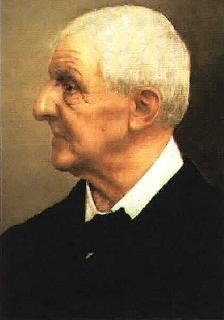Devote
 What kind of a person was Anton Bruckner?. Mahler describes
him as half an idiot, half a genius. Very devote, falling in love with teenage
girls even at higher age, keeping a photo of his dead mother (as he had no
photo from her still alive....). It indeed pictures a remarkable man. Also an
insecure man it looks like when it concerns his work. For most of his
symphonies we know of many re-writes as Bruckner wanted to please his critics
of whom there were many.
What kind of a person was Anton Bruckner?. Mahler describes
him as half an idiot, half a genius. Very devote, falling in love with teenage
girls even at higher age, keeping a photo of his dead mother (as he had no
photo from her still alive....). It indeed pictures a remarkable man. Also an
insecure man it looks like when it concerns his work. For most of his
symphonies we know of many re-writes as Bruckner wanted to please his critics
of whom there were many.
Max Kalbeck, a friend of Brahms wrote in the Wiener
Allgemeine Zeitung, February 13, 1883:
The tonal ghosts are altogether
too mad: it is as though a pack of wolves met on Walpurgis Night, such stamping
and roaring, raging and screaming goes wildly on. If the future can relish such
a chaotic piece of music, with sounds echoing from a hundred cliffs, we wish
that future to be far away from us.
Where Bruckner had no struggle was with his devotion to God: he
believed. Where we see in Mahler searching for God in Nature and in himself and going from assurance to doubt, Bruckner sang of his
God and for his God. His 9th symphony was dedicated to God and he hoped He
would grant him the time to finish it. Which didn't happen as he had to leave the work unfinished.
Bruckner studied intensively the music of Palestrina and
Bach and after working as an organist at the court of Vienna and taken over
from his teacher Sechter his professorship at the Vienna Conservatory, he spent
his final decades creating his nine symphonies. These symphonies are sometimes
refer to as "cathedrals of sound". Mahler expands the scope of the symphony even
further - he famously argued with Sibelius that a symphony should contain the
universe. - and he created an unmistakably modern musical language by including
sounds from the ‘outside world’, using cowbells, military band music, uncommon
wind instruments, mandolins and guitars, even vocal soloists and chorus
My choice here is not for one of these complex symphonies but
his motet Ave Maria. The work dates from 1861 and features three parts for
female and four for male voices. Witzenmann links Bruckner's Ave Maria to four
motets of Palestrina one being the Stabat Mater.
Close your eyes when listening!
No comments:
Post a Comment